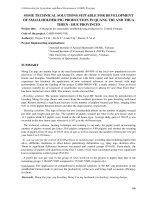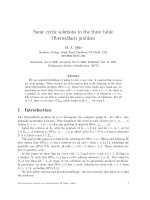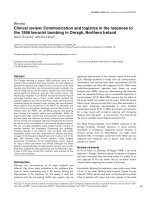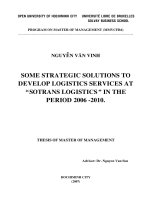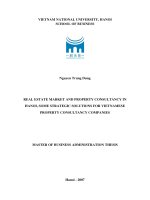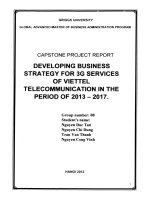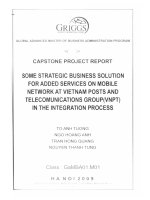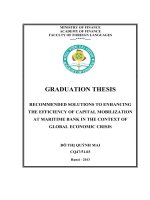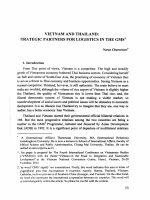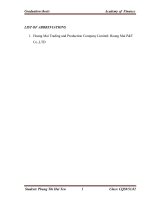Some strategic solutions to develop logistics services at Sotrans logistics in the period 2006 to 2010
Bạn đang xem bản rút gọn của tài liệu. Xem và tải ngay bản đầy đủ của tài liệu tại đây (1006.48 KB, 124 trang )
OPEN UNIVERSITY OF HOCHIMINH CITY UNIVERSITEÙ LIBRE DE BRUXELLES
SOLVAY BUSINESS SCHOOL
PROGRAM ON MASTER OF MANAGEMENT (MMVCFB6)
NGUYEÃN VAÊN VINH
SOME STRATEGIC SOLUTIONS TO
DEVELOP LOGISTICS SERVICES AT
“SOTRANS LOGISTICS” IN THE
PERIOD 2006 -2010.
THESIS OF MASTER OF MANAGEMENT
Advisor: Dr. Nguyen Van Son
HOCHIMINH CITY
(2007)
“I confirm that this is my work. Any data, result
or quote in the thesis are clearly identified”
Nguyen Van Vinh
i
ABSTRACT
The trend of internationalization in economic activities has more rapidly
increased, trade relations among countries have continuously developed in all
fields. Serving these relations, many services industries appear accompany to the
development of international trade activities including forwarding and logistics
services.
Although forwarding activity has appeared for long time, but the concept of
Logistics service has just appeared in recent years, a forwarding company with
large or small size has some problems to be considered. Because the
development is accompanied to fierce competition, always has customers with
higher and higher demands, always asks for something new. How are these
problems solved? and how the company can be survived in this competition ?
That is the reason why it is necessary to study this theme.
Form that point of view, an understanding about the logistics services in Viet
Nam , using SOTRANS LOGISTICS as an example, is necessary. This research
investigates logistics services service at SOTRANS LOGISTICS and some
strategic solutions to push up this services are then presented in order to improve
the company ‘s performance in further .
In this paper, some recommendations for the government and concerned
authorities are suggested with the hope that logistics services will be more
developed and get more profits for the country in the further.
ii
ACKNOWLEDGEMENT
This Master thesis represents the essence of our achievements during two years in
studying at MMVCFB6. During this period there have been many peoples who has
inspired and guided us through the works with the thesis.
We would first like to express my profound gratitude to Dr. Nguyen Van Son -
Research advisor - for his precious guidance, constructive comments, explicit
direction and encouragement and everlasting enthusiastic support throughout the
research period.
My acknowledgements are due to MMVCFB – the Vietnamese and
Belgium Master Program, Vietnamese Professors and Belgium Professors of the
program from Solvay Business School and who gave me a great chance to obtain
valuable knowledge and long term relations.
My sincere thanks are also extended to SOTRANS LOGISTICS and our
colleagues who accompanied us during our works, and made this time
memorable.
Thank all MMVCFB6 members and the faculty of the Hochiminh City
Open University for their help.
Last, but no least, Thanks to all our family, my parents, my lovely wife,
my daughter for their love and understanding during my study wherever we are
you are always with us.
iii
COMMENTS OF THE ADVISOR
Commentator : PhD. Nguyen Van Son, study consultant. This is the
comment on the thesis of the student as Mr.Nguyen Van Vinh – Major: Master of
Management. Thesis title :” Some strategic solutions to develop logistics
services at “Sotrans Logistics” in the period 2006-2010”.
COMMENTS
1. Comment of the thesis :
The thesis is practically efficient for its restructure to modernize the
operation of Sotrans Logistics ( and system of Sotrans Company ) .
The author defines the right research objectives, applies suitable study
methods as well as its outline
The research contains many good new, creative and scientific matters. It
appraises the real situation logistics activities of Sotrans Logistics
reasonably as well as shows out good and weak points of this enterprise.
As per the appraisement, the writer suggests persuadable and feasible
solutions that may be applied to Sotrans Logistics in particular and any
logistics services enterprises in Vietnam in general.
However, the thesis has not avoid some weak points as some unclear and
non-detailed solutions. For example, some solutions of co-working
iv
between subsidiaries of Sotrans Company to develop its strength are not
concretized for immediate application.
Generally, this thesis may be considered as meeting well requirements
about format and contents of an MBA thesis.
2. Comments about the students :
The student – Nguyn Vn Vinh shows his devoted in studying, his creative
abilities on the scientific research and to be recognized as Master of
Management degree.
I agreed to allow the student - Nguyn Vn Vinh to represent this thesis on
Examining Panel at Ho Chi Minh Open University and Solvay Business School
/ University Libre of Bruxelles.
Ho Chi Minh city, Febuary 12 th 2007
THE ADVISOR
Doctror . NGUYN VN SN
v
COMMENT OF CRITICAL PROFESSOR 1
vi
COMMENT OF CRITICAL PROFESSOR 2
vii
TABLE OF CONTENTS
ABSTRACT i
ACKNOWLEDGMENT ii
INTRODUCTION iii
TABLE OF CONTENT VI
LIST OF CHARTS XII
LIST OF FIGURES XIII
CHAPTER 1
BASIS AND REALITY ON LOGISTICS OVERVIEW
1.1 General view about Logistics 1
1.1.1 Concepts and roll of Logistics 1
1.1.1.1 Overview developing situation about modern Logistics 1
1.1.1.2 Logistics concepts 7
1.1.1.3 Logistics concept according to the author 8
1.1.1.4 The role of Logistics 9
1.1.2 Overview about operations of Logistics Services Provider (LSP) 10
1.1.2.1 Logistics Services Provider (LSP) 10
1.1.2.2 Services provided by LSP 10
1.1.3 Classification of Logistics companies 13
1.1.4 Tendency to use Logistics service in the world 15
1.1.4.1 Tendency to rent outside Logistics services 15
1.1.4.2 Customer tendency to control orders on-line 17
1.1.4.3 Customer’s tendency about Logistic solution 17
viii
1.1.5 Experience in development of Logistic service in the region and 18
Development tendency of outsourcing Logistics service in Vietnam
1.1.5.1 Experience in development of Logistics service in the region 18
1.1.5.2 Development tendency outsourcing Logistics activity in Vietnam 20
1.2 Real situation in developing Logistics service in Vietnam 21
1.2.1 Legal basis in doing logistics service in Vietnam 21
1.2.1.1 The trading condition of Logistics service 22
1.2.1.2 Rights and Liabilities of Logistics traders 22
1.2.1.3 Rights and Liabilities of customers 23
1.2.1.4 Exempt responsibility cases for Logistics trader 23
1.2.1.5 Logistics trader’s liabilities once holding goods 24
1.2.2 Some logistics services applied in Vietnam 24
1.2.2.1 Supply Chain Management 25
1.2.2.2 Forwarding and co-loading service 27
1.2.2.3 Airfreight service 28
1.2.2.4 Warehousing – Distribution service 29
1.2.3 Opportunities and Challenges 31
1.2.3.1 Opportunities 31
1.2.3.2 Challenges 32
CONCLUSION OF CHAPTER 1 34
CHAPTER 2
THE REAL SITUATION IN LOGISTICS
DEVELOPMENT AT “SOTRANS LOGISITCS)
2.1 Sotrans’ overview 36
2.1.1 Sotrans’ history 36
ix
2.1.2 Business activities 37
2.1.3 Acitivities network 38
2.1.3.1 Member direct under controlled by Sotrans Corporation 38
2.2 General description of Sotrans Logistics
2.2.1 Sotrans Logistics’ overview 40
2.2.2 Functions and Mission 41
2.2.3 Structure 41
2.3 Analysis of business activities and logistics services in Sotrans Logistics 42
2.3.1 Analysis of Sotrans’ business activities 2003-2006 42
2.3.1.1 By turnover 42
2.3.1.2 By profit 46
2.3.2 Analysis of Sotrans’s Logistics services 48
2.3.2.1 By services structure 48
2.3.2.2 By character and complexity of services 52
2.3.3 Sotrans Logistics’ Agency Network 56
2.3.3.1 Overview of oversea agency network 56
2.3.3.2 Policy of Sotrans Logistics on relationship with oversea partner 59
2.3.4 Information System 61
2.3.5 Customer service 63
2.3.5.1 Strength – Advantages 64
2.3.5.2 Weaknesses – Disadvantages 65
2.3.5.3 Chances 66
2.3.5.4 Challenges 66
x
CHAPTER 3
SOME STRATEGIC SOLUTIONS TO DEVELOP LOGISTICS SERVICES
AT “SOTRANS LOGISTICS” IN THE PERIOD 2006-2010
3.1 The orientation of developing the goals of Logistics service in Sotrans 68
Logistics in the period of 2006-2010
3.1.1 Orientations 68
3.1.2 The objectives of development for period 2006-2010 68
3.2 Strategic solution Systems to develop Logistics service in Sotrans 69
3.2.1 Solution group of developing products and services 69
3.2.1.1 Focusing on developing International Transportation 69
3.2.1.2 Developing consolidation cargo 71
3.2.1.3 Developing the model of cargo delivery service under DDP term 71
3.2.1.4 Improving operating effects of warehouse and cargo distribution 73
3.2.1.5 Improving customer services 74
3.2.2 Solutions of developing the agent network and joint venture partner 76
3.2.2.1 Developing of agent network 76
3.2.2.2 Solutions to push up co-working among subsidiaries of 80
Sotrans Corporation
3.2.2.3 Solution for choosing and developing supplier 82
Logistics company
3.2.3 Group of solutions to performing 83
3.2.3.1 Developing the information system 83
3.2.3.2 Human resource developing and training program 86
3.2.3.3 Deploying the Customer oriented Sales & Marketing program 89
3.2.4 Solutions for re-structuring & reforming the management 90
3.3 Recommendation 94
xi
3.3.1 For the Head of company Sotrans 94
3.3.2 For forwarding Association 95
3.3.3 For other industries 96
3.3.4 For the Government 96
3.3.5 Some recommendations to general customs 97
CONCLUSION 101
REFERENCE DOCUMENTS 102
xii
ABBREVIATIONS
AFTA : ASEAN Free Trade Area
CIF : Cost, Insurance and Freight (Incoterm)
DDP : Delivery Duty Paid (Intercom)
DDU : Delivery Duty Unpaid (Intercom)
EDI : Electronic Data Interchange
Exw : Ex works (Intercom)
FOB : Free On Board (Incoterm)
IATA : International Air Transport Association
JIT : Just in Time
KPI : Key Performance Indicators
LSP : Logistics Service Provider
SCM : Supply Chain Management
SOTRANS : South Transportation Warehousing Company
SKU : Store Keeping Units
USD : Currency of the United States.
VND : Currency of Vietnam
VIFFAS : Viet Nam International Freight Forwarding Association
WTO : The World Trade Organization
xiii
LIST OF CHART
Chart 1 : Forwarding department of turnover period 2003-2006 43
Chart 2 : Airfreight services of turnover period 2003-2006 44
Chart 3: sea freight services of turnover period 2003-2006 44
Chart 4: Sotrans Logistics of profit period 2003-2006 46
Chart 5 : Forwarding services profits period 2003-2006 47
Chart 6: Airfreight services of profit period 2003-2006 47
Chart 7 : Sea freight services of profit period 2003-2006 47
Chart 8 : Sotrans Logistics of revenues by market sector 52
Chart 9: Standard Operating Procedures – DDP – JIT for Client “Scavi Europe” 54
Chart 10 :Sotrans Logistics services by the agent 59
xiv
LIST OF FIGURES :
Figure 1 : Material Management / Inbound Logistics 2
Figure 2 : Product distribution / Outbound Logistics 3
Figure 3 : Logistics Systems (Trading Logistics) 4
Figure 4 : Logistics and Supply Chain 6
Figure 5 : Scale and Augmentation speed of Vietnamese and World 20
Logistics Market in year 2005.
Figure 6 : Main sub-division of Vietnamese logistics market 2005 21
Figure 7 : Relationship between parties in supply chain Management/ Logistics 25
Figure 8 : Structure of Sotrans Logistics 42
Figure 9 : Sotrans Logistics of Turnover report 42
Figure 10 : Sotrans Logistics of profit report 46
Figure 11 : Advantages of EDI systems 62
Figure 12 : The adjusted structure of company 92
xv
INTRODUCTION
1. Reason to choose the subject:
The more economy, science and technology develop, the more “supply” and
“demand“ about goods, services on the market becomes diversified. Consumers
desire to be satisfied their needs rapidly, conveniently. In the mean time, the
suppliers always find all possibilities to launch their products into the market at
earliest time, to meet all customers’ needs. Logistics is just the effective tool that
the suppliers take advantage to achieve their purpose.
Nowadays, the notion of logistics has become very familiar with almost all
businessmen. Many enterprises employ professional logistics companies
effectively. In recent years, number of logistics companies has increased
considerably in Vietnam (There is currently about 900 companies. Average
increasing speed is 10% per year. That means this quantity will be approximately
1,300 companies within the next 5 years). However, the operations of many
logistics companies is nothing difference with normal forwarders. Forwarding
market is very rag, almost forwarding companies are medium and small.
In this context, the studying of logistics and developing logistics service in
forwarding companies are very essential, especially when there is few authors
research on this subject in Vietnam, reference documents are limited. Besides,
when Vietnam became official member of the World Trade Organization
(WTO), we need to intensify more on movement of economy mechanism in
direction of developing services. This can reduce the dangers that foreign
companies exploit service activities in general and forwarding activities in
particular.
xvi
With above-mentioned reasons, I have decided to choose the subject
“ Some
Strategic solutions to develop Logistics service at “Sotrans Logistics” in the
period 2006 - 2010”
as the thesis of the graduation composition.
2. Research’s purpose
Know thoroughly the notion of Logistics, the nature of Logistics
Investigate levels of development in Logistics company, evaluate actual
level of Vietnamese Logistics companies.
Bring out the development orient and typical solutions of development in
order to upgrade the operations at Sotrans Logistics.
3. Object and scope of the research
Research object: Services in Logistics Supply Chain
Research scope: Sotrans Logistics.
4. The new point and application value of the thesis:
This thesis is the result for my studying about Logistics matter at some
companies in the world, within process of working and studying. The thesis
summarizes and mentions about basic logistics matters and the application of
logistics into real situation in our company.
Application value of the thesis is giving real solutions to develop logistics service
at Sotrans Logistics in period 2006 – 2010.
5. Structure of the thesis:
Including 3 chapters:
Chapter 1: The basis and reality on Logistics Overview
xvii
Chapter 2: Real situation in Logistics services development at “Sotrans
Logistics”.
Chapter 3: Some Solutions to developing logistics services at “Sotrans Logistics”
in period 2006-2010.
1
CHAPTER 1
BASIS AND REALITY ON LOGISTICS OVERVIEW
1.1. General view about Logistics:
1.1.1. Concepts and role of Logistics
1.1.1.1 Overview developing situation about modern Logistics
Nowadays, our modern world develops strongly with advances in science-
technology which happen every day, every hour. In these advances, the launch
and development of information technology has contributed greatly to expand of
business activities. The quantity of transaction goods has increased many times
than before which hastens the process of specialization, liberalization and
globalization of the world economy.
The development of information technology creates good conditions to the
information network is expanded. Information is transmitted rapidly, accurately.
This is one of the premises for modern Logistics create and develop with great
progresses.
After the seconds World War, the new economy was formed with two poles:
United States - Western Europe. Along with miraculous achievement, Japan
gradually appears on World Map as the Third pole, walking abreast with the two
giants United States and Western Europe. Almost all business innovations are
raised from this enormous economy. As a result, Logistics grow up powerfully
there. This development represents clearly over every decade.
2
Decade 1960:
In years 1960-1970, most companies has changed from partial management
model with separate process such as: transportation, purchasing and warehousing
to overall management model of relevant functions under two processes called:
Materials management (Figure 1) and Product distribution (Figure 2). Materials
management is determining, organizing, controlling all activities as well as
human resources relevant to input materials. Materials management includes the
functions as material purchasing, administering goods rotating in productions
process, internal transportation, making production plan. Product distribution is
the activities in order to move finished products at the end of the production line
to customers. It includes the functions as transportation, warehousing, packaging,
order executing, demand forecast, inventory control and customer service.
Material supplying
point
Transport
Transport
Material
Supply
Factory
Warehousing
Figure 1: Materials management/ Inbound Logistics
3
Factory
Warehousing
Production
Transport
Transport
Finished product
Market
Consuming
location
Figure 2: Product distribution/ Outbound Logistics
Before 1960, managers are inclined to consider distribution activities is common
and trivial and do not pay attention on. This leads to accelerating and irrational.
This cost mixes into indirect cost, general cost of the company and make people
determine hardly the actual level of transportation expenditures in order to
administer goods effectively.
Decade 1970:
Until years 1970, the operating cost of companies increase highly. Severe
inflation has reached until two numerals. As a result, labor cost, workshop,
Capital cost has increased remarkably and make the distribution cost raises. On
the other hand, petrol and oil prices escalate since OPEC claims to cut down on
the supply in the market. This forces managers to find out new methods to
connect distribution functions. The liberalization in transport industry also gives
the managers new options to reduce costs, put up operations effect. Therefore,
until the end of years 1970, Material Management and Product Distribution have
considered to be an organic overall process from material inputs until the
finished products will be on the market and the terms Trading Logistics has
been more expanded (Figure 3).
4
Material
su
pp
l
y
in
g
p
oint
Transport
Finish
ed Product
Inbound Logistics
Inventory
Factory
1
Inventory
Transport Transport
Transport
Material
inventor
y
Production Product
inventor
y
Market
Outbound Logistics
Consuming
point
Input
Figure 3: Logistics system (Trading Logistics)
Decade 1980:
In decade 1980, the development of Logistics is marked obviously. The taking
off obstacles in regulations, the expanding of Logistics services makes the
relationship between the carrier and the shipper changed. The carriers
concentrate all possibilities to reduce the freight rate in order to save transport
cost. In the mean while, shipper concentrate goods into few carriers that they
highly appreciate in order to have better negotiation result for their goods
distribution job. That’s why the numbers of shippers seems to be fewer but the
business jobs of a certain carrier grow much. Therefore, carriers have to try their
utmost in order to be into the contractor list that shipper choose. Successful
contractors are the ones who have prominent customer service, attractive value
added service and reasonable price. Series of normal practices have come when
carriers and shippers want to cut down costs improve service, including issuing
invoices and control freight automatically, using Data Exchange System EDI
(Electronic Date Interchange) to assist the use of electronic invoices without
paper, tracing cargo, self-apply and calculate the freight cost, follow complaints,
freight payment,…
5
Also in decade 1980, many companies have changed their mechanism to
enhance competitive capacity and avoid to be merged by other companies.
World trading develops strongly, service industry breaks out rapidly. Logistics
service providers much more appear, “Just in time” system (JIT) of Japan also
comes out in this period. Basic principle of this system is, do not manufacture or
transport goods once haven’t received order. In other words, JIT system wish to
achieve the purpose of material, goods supplying according to actual needs of
customers in shorted time, minimize storage cost. In order to obtain this, the
matter of settling and transferring information is very important. Timely and
precise information replace for the production based on forecast and product
inventory. JIT system will react swiftly under “drawbridge” form, that is, actual
demand will be informed timely and the system only create a corresponding
supplying amount.
Decade 1990:
Until decade 1990, when the activity of many companies has been saturated in
national market, they have to cut down their costs in order to be more effective
and penetrate into oversea market. The matters to shorten the time that goods
are put into the market and improve quality service are other important elements
in order to enhance competitive advantage of the enterprise. Collecting all strict
requirements about costs, time and quality service, managers have to find out
new effective tools to improve, develop continuously their businesses. This tool
is improving Logistics activities. However, obtaining this effective tools is not
simple, since the companies have to invest new technology, especially
information technology, expand their system worldwide, develop human
resource,….Therefore, in order to cut down cost, goods distribution time, improve
6
quality activity but do not have to invest with high expenditure, as well as the risks
of these investments, many enterprise have rent professional Logistics service
providers implementing their whole Logistics activities.
Also in this period, while the system of these companies more and more expand
with the establishment of multinational companies operating all over the world,
the policy of these companies has transferred to specialization tendency one of
some products at manufacturing regions having advantages about material and
manpower. After that, assembling factories will associate the units of the product
together accordingly each stage. The factories can be located far away, from this
country to another country, from this continent to another continent. This brings
about many subjects participating into supply chain and Logistics activity has
been more expanded. The concept “Supply Chain” has appeared in this period as
an extended term of Logistics (Figure 4).
Figure 4: Logistics and Supply Chain
